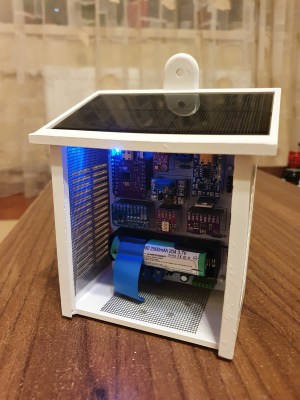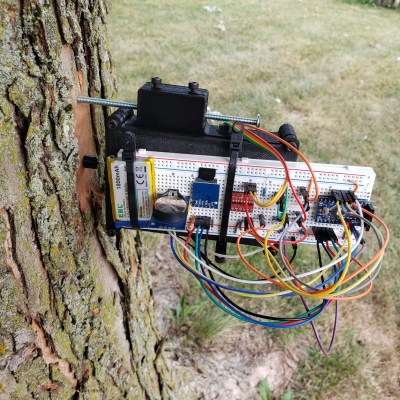Holy humanitarian hacking, Batman! We asked you to come up with your best climate-forward ideas, and you knocked it out of the ionosphere! Once again, the judges had a hard time narrowing down the field to just ten winners, but they ultimately pulled it off — and here are the prize-winning projects without much further ado.
In the Climate-Resilient Challenge, we asked you to design devices that help build communities’ resilience to severe weather and the increasing frequency of natural disasters due to climate change, and/or devices that collect environmental data that serves as hard evidence in the fight for changes in local infrastructure. While several people focused on air quality, which is something we tend to think of as a human need, plenty others thought of the flora and fauna with which we share this planet.
Breathe In the Air
 A handful of hacks had to do with air quality, both within our private homes and our public spaces. [Ovidu]’s solar-powered air quality monitoring station addresses the former, using IoT notifications to let you know when the pollution of rush hour is mucking up the molecules in your man cave (and elsewhere in your castle).
A handful of hacks had to do with air quality, both within our private homes and our public spaces. [Ovidu]’s solar-powered air quality monitoring station addresses the former, using IoT notifications to let you know when the pollution of rush hour is mucking up the molecules in your man cave (and elsewhere in your castle).
While it’s great to make sure you’ve secured good air quality at home, some hackers took it a step further and monitored problems at the neighborhood scale — and beyond. Imagine you live near a factory — a circumstance that looks to be on the rise in the US.
Wouldn’t you want that factory to have good environmental practices? And if they didn’t, you’d want to have hard evidence of that to show the court, right? That’s what [Guillermo Perez Guillen]’s project is all about — it’s an environmental tool kit for an entire ecological area.
While that factory example might be exclusive of many people, plenty of regular, singular human beings litter everywhere, all the time — even in otherwise beautiful, serene settings like the shores natural lakes and rivers. While this device will not police the people, it will relay all the data it can about the air and water quality over LoRaWAN.
Somewhere between the city lights and wherever we spend the night, there are public places to consider. [Avye]’s lovely Air Quality Pavilion aims to be a pop-up solution wherever the environment calls for one. As more of the social world comes back online, concern for indoor air quality monitoring is through the roof. The Pavilion as-built is a scaled-down version of [Avye]’s vision for a temporary structure that provides shelter for all kinds of activities while monitoring the environment for changes. Too many bodies breathing on the dance floor? First, the green-lit windows turn red to warn everyone. Then the pavilion pivots, opening shutters in the walls and skylights in the ceiling to keep the party going safely.
Don’t Be Afraid to Care (About Trees, Bees, and Crops)
 The effects of climate change don’t just stress out the humans — drought effects everything that needs water to live and flourish, and that includes our carbon dioxide-eating friends the trees. [John Opsahl] knows what a lot of us didn’t — that trees change diameter throughout the day in small but detectable fashion, and that these changes can be indicative of water stress.
The effects of climate change don’t just stress out the humans — drought effects everything that needs water to live and flourish, and that includes our carbon dioxide-eating friends the trees. [John Opsahl] knows what a lot of us didn’t — that trees change diameter throughout the day in small but detectable fashion, and that these changes can be indicative of water stress.
On the plus side, these deviations also make it possible to track the progress of a fruit tree through to harvest the same way, by using a digital tire tread depth gauge like a one-armed caliper. The measurements are level-shifted and processed by a microcontroller, which gives them a timestamp and stores them on an SD card.
Similarly, [Florian Ellsäßer]’s Crop Water Stress Sensor does what it says on the tin — it measures the stress of drought conditions on plants and logs the data to an SD card, though the next version is going wireless in order to share with sensor networks.
[Gouttebroze] lives in France, where there are approximately one million beehives, all of which are in relative danger in the grand scheme of things. With the help of a temperature sensor, an Arduino Nano, and a load cell bar, [Gouttebroze]’s Beehive Monitoring and Tracking project aims to do a number of things, including monitoring the weight of the hive to determine the bees’ health, honey production, and more.
Congratulations!
Our ten Climate-Resilient Communities finalists more than deserve their $500 prizes, and will all be eligible to win even bigger when we announce the Hackaday Prize winners at Supercon in November. Until then, Hackaday Prize has moved on to the Wildcard Challenge, and everyone is just trying to save the planet in whatever way they can, because it sure is bleeding from many places. Roll up your sleeves and get wild!
Many thanks again to our sponsors, Digi-Key and Hackaday’s parent company, Supplyframe, for sponsoring the 2022 Hackaday Prize.
The Climate-Resilient Communities Finalists
"congratulations" - Google News
September 29, 2022
https://ift.tt/y6sXzLp
2022 Hackaday Prize: Congratulations To The Winners Of The Climate-Resilient Communities Challenge - Hackaday
"congratulations" - Google News
https://ift.tt/foHp0lM
Shoes Man Tutorial
Pos News Update
Meme Update
Korean Entertainment News
Japan News Update
Bagikan Berita Ini


















0 Response to "2022 Hackaday Prize: Congratulations To The Winners Of The Climate-Resilient Communities Challenge - Hackaday"
Posting Komentar